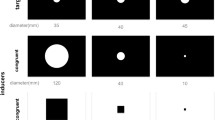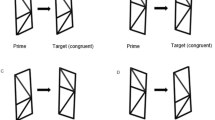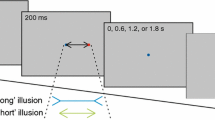Abstract.
In the Judd illusion, observers inaccurately bisect the shaft located between two arrowheads pointing in the same direction. The magnitude of error is greater when verbal judgements are compared to action based responses (reaching out and grasping the centre of the bar). This difference has been attributed to the presence of two visual streams within cortical processing. In contrast, we provide evidence that the improved accuracy in the reaching condition may be due to occlusion of the illusory background during the transport phase of the movement. We suggest that caution is required when interpreting performance differences between two conditions that are not strictly equivalent.
Similar content being viewed by others
Author information
Authors and Affiliations
Additional information
Electronic Publication
Rights and permissions
About this article
Cite this article
Mon-Williams, M., Bull, R. The Judd illusion: evidence for two visual streams or two experimental conditions?. Exp Brain Res 130, 273–276 (2000). https://doi.org/10.1007/s002219900258
Received:
Accepted:
Issue Date:
DOI: https://doi.org/10.1007/s002219900258




